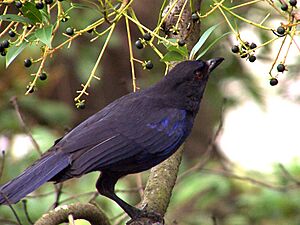Taiwan whistling thrush facts for kids
Quick facts for kids Taiwan whistling thrush |
|
|---|---|
 |
|
| Conservation status | |
| Scientific classification | |
| Genus: |
Myophonus
|
| Species: |
insularis
|
| Synonyms | |
|
Myiophonus insularis |
|
The Taiwan whistling thrush (Myophonus insularis) is a beautiful bird found only in Taiwan. It's also called the Formosan whistling thrush. This bird belongs to the Muscicapidae family, which includes many types of thrushes and flycatchers. Being "endemic" means it naturally lives nowhere else in the world.
Contents
About the Taiwan Whistling Thrush
The Taiwan whistling thrush was first found by Robert Swinhoe. He described it as a "Formosan cavern-bird" because it lived in dark, wooded areas in the mountains. In 1862, John Gould officially named and described this bird.
This thrush was once thought to be a type of Malabar whistling thrush. However, scientists later decided it was its own unique species. It is a "monotypic" species, meaning it does not have any subspecies.
Where It Lives
This special bird lives only on the island of Taiwan. Its favorite home is in moist montane forests. These are forests found in mountains where it's often wet. You can find these birds living at high places, up to about 2,700 meters (8,858 feet) above sea level.
What It Looks Like
The Taiwan whistling thrush is about 28 to 30 centimeters (11 to 12 inches) long. Its wings are about 15 to 16 centimeters (6 inches) long. Most of its body is a dark, blackish-blue color. Some of its feathers can look navy blue or even shiny metallic blue.
Its underparts are blackish, and its neck, chest, and sides have a scaled pattern. This means the feathers look like small scales. The bird has deep red eyes. Its beak and legs are black. Both male and female birds look very similar. Young birds are duller black with a slight blue tint. Their mouths are yellowish.
Daily Life and Habits
These birds are most active during sunrise and sunset. They like to hop among rocks in forest streams. You might often see them opening and closing their tails while sitting on a rock.
The Taiwan whistling thrush has a sharp whistle call, which sounds like "screee." Its song is very loud and beautiful, made up of many melodious whistles.
Reproduction and Life Cycle
The Taiwan whistling thrush is a "monogamous" bird. This means one male and one female bird stay together to raise their young. Their breeding season is from late March to early September. They usually have two sets of babies each year.
Nests are often built in holes found in rocks or trees. Sometimes, they even build nests in human-made structures. They build their nests using twigs, roots, stems, and moss. A female bird usually lays 2 to 4 eggs. The eggs are pinkish with brownish or grayish spots.
The female bird sits on the eggs to keep them warm. This is called incubation, and it takes about 12 to 14 days. When the chicks hatch, they are "altricial." This means they are born very helpless with few feathers. Both parents work together to feed the baby birds. The young birds leave the nest when they are about 21 days old.
What It Eats
The Taiwan whistling thrush finds its food in or near streams. Its diet includes shrimp, earthworms, insects, frogs, small reptiles, and fish.
Conservation Status
The International Union for Conservation of Nature (IUCN) has looked at the Taiwan whistling thrush. They have listed it as a species of "least concern." This means it is not currently in danger of disappearing.
However, its population is estimated to be between 10,000 and 100,000 breeding pairs. Scientists think this number might be going down. This is mainly because of "habitat destruction," which means their natural homes are being damaged or removed. The bird was once on Taiwan's list of protected species but was removed in 2008.
See also
- List of protected species in Taiwan
- List of endemic species of Taiwan
- List of endemic birds of Taiwan


